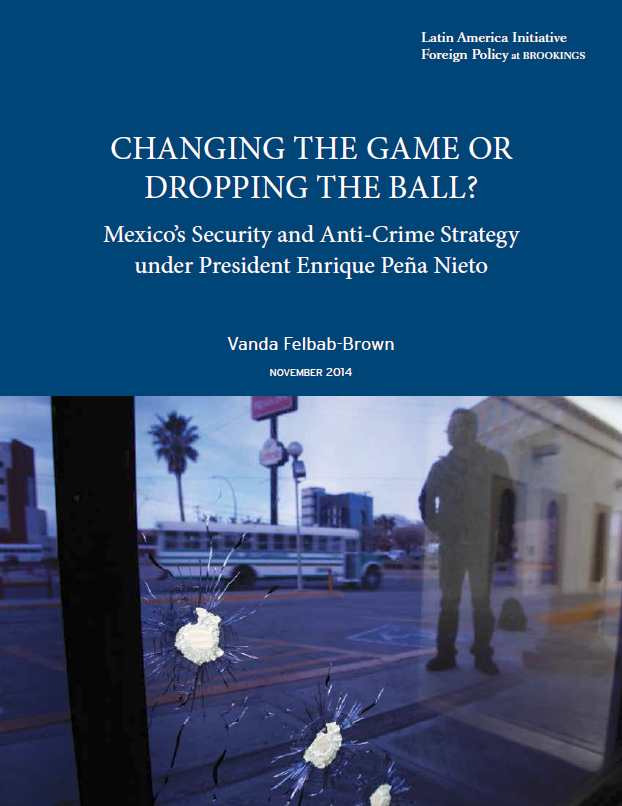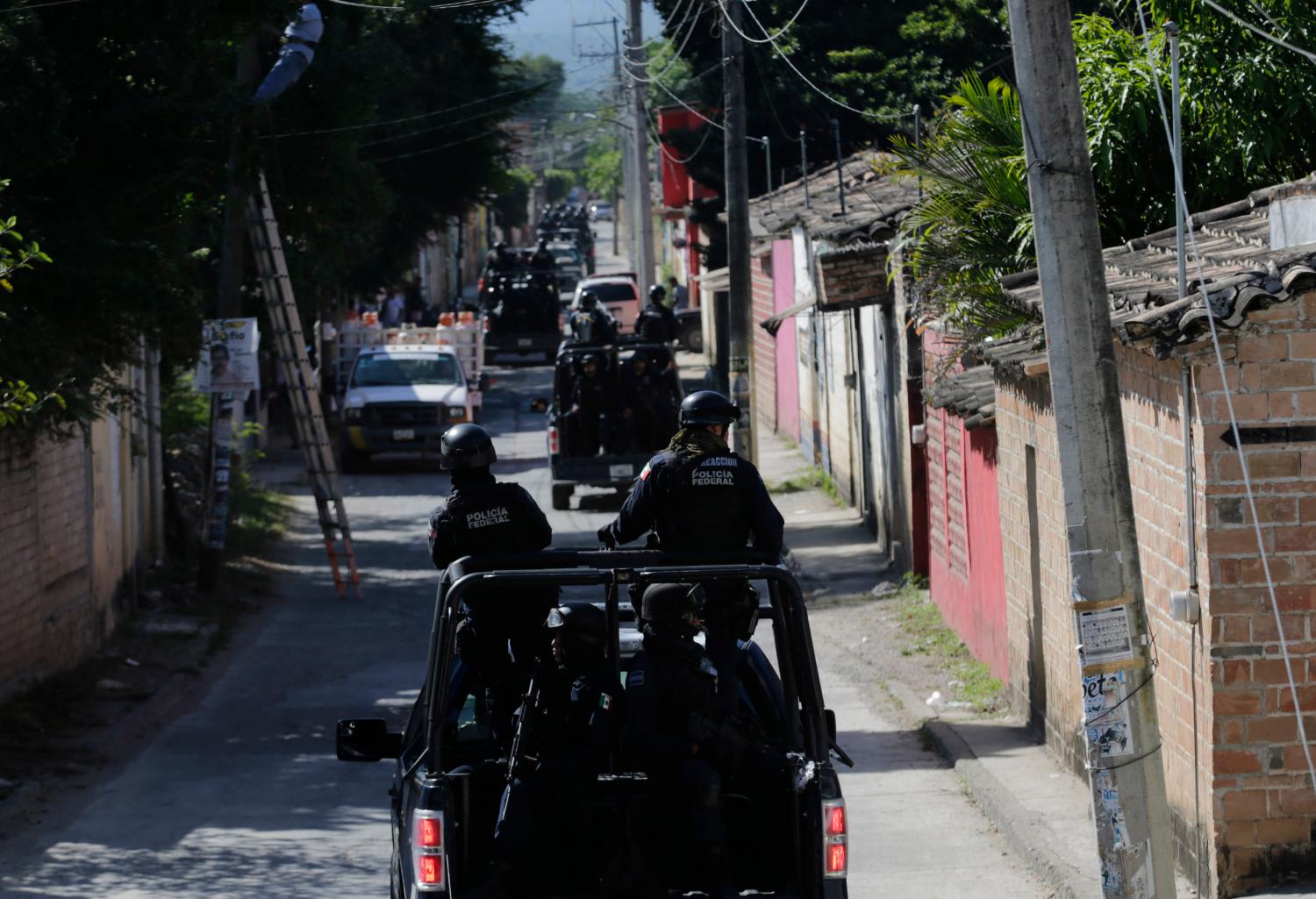 While Mexico’s President Enrique Peña Nieto has scored important reform successes in the economic sphere, his administration’s security and law enforcement policies targeting organized crime remain incomplete and ill-defined. Preoccupied with the fighting among vicious drug trafficking groups and the rise of anti-crime vigilante militias in the center of Mexico, the Peña Nieto administration has, for the most part, averted its eyes from the previously highly violent criminal hotspots in the north, where major law enforcement challenges remain.
While Mexico’s President Enrique Peña Nieto has scored important reform successes in the economic sphere, his administration’s security and law enforcement policies targeting organized crime remain incomplete and ill-defined. Preoccupied with the fighting among vicious drug trafficking groups and the rise of anti-crime vigilante militias in the center of Mexico, the Peña Nieto administration has, for the most part, averted its eyes from the previously highly violent criminal hotspots in the north, where major law enforcement challenges remain.
The Peña Nieto administration thus mostly continues to put out immediate security fires—such as in Michoacán and Tamaulipas—but the overall deterrence capacity of Mexico’s military and law enforcement forces and justice sector continue to be very limited and largely unable to deter violence escalation and reescalation.
Making the reduction of drug-related violence the country’s most important policy priority was the right decision. But despite the capture of Mexico’s most notorious drug trafficker, Joaquín “El Chapo” Guzmán, much of the security policy reform momentum present at the outset of Peña Nieto’s six-year term has prematurely dissipated.
Key Vulnerabilities of Nieto Administration Policies to Reduce Violence
- Instead of pushing ahead with institutional reforms, the Peña Nieto administration has highlighted poor coordination among national security agencies and local and national government units as a crucial cause of the rise of violent crime in Mexico.
- Despite its rhetoric and early ambitions, the Peña Nieto administration fell straight back not only into relying on the Mexican military in combination with the Federal Police to cope with criminal violence, but also doing so belatedly and with an essentially analogous lack of planning and prepositioning, and with essentially the same operational design as the previous Felipe Calderón administration.
- Although homicides, including those perpetrated by drug trafficking organizations, have decreased in Mexico, the drop did not reach the 50 percent reduction in the first six months in office that the Peña Nieto administration had promised. Moreover, in various parts of Mexico, the violence reduction cannot be necessarily attributed to government policies, but rather is the outcome of new balances of power being established among criminal groups in previously highly contested hotspots.
- In its security and law enforcement efforts, the Peña Nieto administration has largely slipped into many of the same policies of President Felipe Calderón. In particular, the current administration has adopted the same non-strategic high-value targeting that defined the previous administration.
- Importantly, the Peña Nieto administration has sought to pay greater attention to and respect for human rights issues, such as by allowing civilian claims of human rights violations by Mexico’s military forces to be tried in civilian courts and establishing a victims’ compensation fund. But the efforts to increase rule of law, justice and the protection of human rights and to reduce impunity and corruption remain very much a work in progress, with the government’s resolve, policies and outcomes varying widely among Mexico’s states.
- The Peña Nieto administration’s focus on socio-economic anti-crime policies and other crime prevention measures is highly laudable. But its signature anti-crime socio-economic approach—the so-called “polígonos” program—has not been well-operationalized and is not integrated with law enforcement efforts.
RECOMMENDATIONS
Overall, the Mexican government must develop a comprehensive law enforcement strategy beyond high-value targeting, sharpen its anti-crime socio-economic policies and better integrate them with policing. This involves:
- Making Interdiction More Strategic
Interdiction must move beyond the current nonstrategic, non-prioritized, opportunistic targeting posture. The most dangerous groups should be targeted first, with an eye toward local stability. Targeting plans should be based on robust assessments of the violence hits might trigger and with strategies to mitigate and prevent such outcomes (such as through force prepositioning). - Switching from High-Value Targeting to Middle-Layer Targeting
Interdiction should shift away from predominantly high-value targeting to middle-layer targeting. This may seem a marginal technical change; in fact, it has profound positive implications regarding the ability of criminal groups to react to interdiction hits vis-à-vis law enforcement agencies and toward each other, overall limiting their capacity for violent reaction. - Keeping a Law Enforcement Focus on Areas Where Violence Has Declined
The Peña Nieto administration must not avert its eyes from areas where violence has declined; instead it should work with local authorities to deepen police reform and institutionalize rule of law in those areas. It also must analyze why violence has not exploded in other parts of the country and reinforce the stabilization dynamics there by strengthening law enforcement and the rule of law. - Resurrecting A Momentum on Police Reform
In order to strengthen the deterrence and response capacity of its law enforcement, the Peña Nieto administration also needs to double up on police reform by enhancing capacity, beefing up vetting and reducing corruption, adopting proactive and knowledge-based policing methods, achieving a sufficient density of permanent-beat deployments and developing local knowledge. - Doubling Up on Justice and Human Rights
With only two years left to 2016 when the new accusatorial justice system is supposed to be fully functional throughout Mexico, the Peña Nieto administration must make a serious push to assist states in switching to the new system. This must include increased efforts to protect human rights and civil liberties and reduce corruption. - Making the Polígonos Anti-Crime Socio-Economic Interventions More Rounded and Integrated
The logic and mechanisms of specific polígonos projects should be articulated and clarified and subjected to careful evaluation and monitoring. The projects need to be better connected and integrated with one another in a particular area, not discrete isolated programs. Assessments of cross-boundary dynamics and interactive processes across polygons and between polygon and non-polygon areas should be built into the projects’ designs. It is also crucial to integrate the projects’ designs with local law enforcement efforts.
The Brookings Institution is committed to quality, independence, and impact.
We are supported by a diverse array of funders. In line with our values and policies, each Brookings publication represents the sole views of its author(s).




